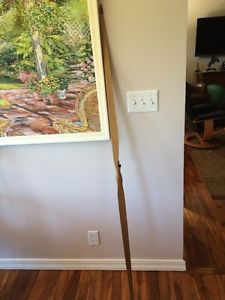Back to the main page Back to category Compound
watch details
Rare Mitch Sowl Signature Bow Long Bow Island Bow Works Longbow Hawaiian
Estimated price for orientation: 299 $
Category: Compound
Class:
Description Condition: New: A brand-new, unused, unopened, undamaged item in its original packaging (where packaging is applicable). Packaging should be the same as what is found in a retail store, unless the item is handmade or was packaged by the manufacturer in non-retail packaging, such as an unprinted box or plastic bag. See the seller's listing for full details. See all condition definitions- opens in a new window or tab ... Read moreabout the condition Brand: Mitch Sowl Country/Region of Manufacture: United States Dexterity: Right Hand Draw Weight (lbs.): NA Model: Island Bow Works Overall Length (in.): 66"
This is a beautiful, Island Works handmade bow - By hunter craftsman Mitch Sowl
Write up:
Vol. 19, no. 3
June/July 2016
Hana Hou!
Arrowsmith
Story by Jon Letman
Photo by Dana Edmunds
You need to get in close without letting them smell you, says Mitch Sowl, “twenty yards or less.” Sowl hunts in the forests of Kaua‘i for pig, goat and black-tailed deer in the old, old-fashioned way: with a longbow. Unlike a gun or even a compound bow, which uses wheels, cables and sights, a longbow is basically just a “stick and string,” says Sowl, who calls it the purest, most challenging way to hunt.
Sowl’s a purist in more ways than one: For the past eighteen years the bowyer has designed and fabricated his own bows, arrows, strings—even building the tools and jigs he needs. He started making bows in 1979, learning the art from master bowyers in Carson City, Nevada.
Each bow requires about ten days to complete. They’re functional, of course, but they’re also beautiful. The limbs are made of finely sanded red elm and maple epoxied between fiberglass laminates, and the “handle risers,” or grips, are made of native koa or exotic woods like purpleheart, osage and cocobolo. Sowl even makes his own bowstrings from Dacron and fletches arrows from Port Orford cedar (he prefers wooden arrows to aluminum or carbon because they’re heavier and have better penetration; one shot can fell an animal as large as a mouflon sheep, and they’re less likely to cause a nonlethal injury.) Once all parts of the bow are sanded, filed, planed to one-thousandth of an inch and clamped into a bow form, Sowl cures them at 150 degrees for four hours, fusing all materials to ensure strength and durability. And they are strong: “I’ve never had one break on me,” says Sowl. To Sowl, longbows are tools—ones that take a lifetime of practice to master. Sowl can show you how to string a bow, but he can’t teach the instincts you need to be successful at hunting with one. You just have to know, he says. “When it’s time to shoot, it’s time to shoot.”
Unique opportunity to own a piece of functional artwork
Description
| Condition: | New: A brand-new, unused, unopened, undamaged item in its original packaging (where packaging is applicable). Packaging should be the same as what is found in a retail store, unless the item is handmade or was packaged by the manufacturer in non-retail packaging, such as an unprinted box or plastic bag. See the seller's listing for full details. See all condition definitions- opens in a new window or tab ... Read moreabout the condition | Brand: | Mitch Sowl |
| Country/Region of Manufacture: | United States | Dexterity: | Right Hand |
| Draw Weight (lbs.): | NA | Model: | Island Bow Works |
| Overall Length (in.): | 66" |
This is a beautiful, Island Works handmade bow - By hunter craftsman Mitch Sowl
Write up:
Vol. 19, no. 3
June/July 2016
Hana Hou!
Arrowsmith
Story by Jon Letman
Photo by Dana Edmunds
You need to get in close without letting them smell you, says Mitch Sowl, “twenty yards or less.” Sowl hunts in the forests of Kaua‘i for pig, goat and black-tailed deer in the old, old-fashioned way: with a longbow. Unlike a gun or even a compound bow, which uses wheels, cables and sights, a longbow is basically just a “stick and string,” says Sowl, who calls it the purest, most challenging way to hunt.
Sowl’s a purist in more ways than one: For the past eighteen years the bowyer has designed and fabricated his own bows, arrows, strings—even building the tools and jigs he needs. He started making bows in 1979, learning the art from master bowyers in Carson City, Nevada.
Each bow requires about ten days to complete. They’re functional, of course, but they’re also beautiful. The limbs are made of finely sanded red elm and maple epoxied between fiberglass laminates, and the “handle risers,” or grips, are made of native koa or exotic woods like purpleheart, osage and cocobolo. Sowl even makes his own bowstrings from Dacron and fletches arrows from Port Orford cedar (he prefers wooden arrows to aluminum or carbon because they’re heavier and have better penetration; one shot can fell an animal as large as a mouflon sheep, and they’re less likely to cause a nonlethal injury.) Once all parts of the bow are sanded, filed, planed to one-thousandth of an inch and clamped into a bow form, Sowl cures them at 150 degrees for four hours, fusing all materials to ensure strength and durability. And they are strong: “I’ve never had one break on me,” says Sowl. To Sowl, longbows are tools—ones that take a lifetime of practice to master. Sowl can show you how to string a bow, but he can’t teach the instincts you need to be successful at hunting with one. You just have to know, he says. “When it’s time to shoot, it’s time to shoot.”
Unique opportunity to own a piece of functional artwork
